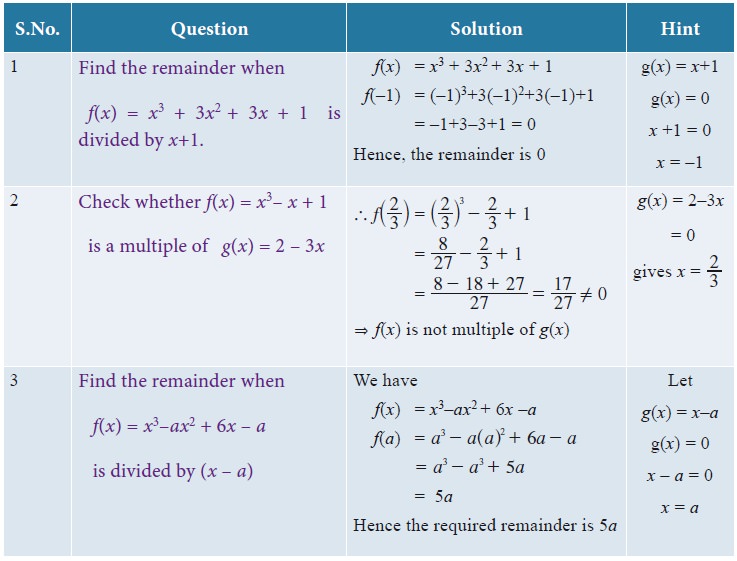Solved Example Problems | Mathematics - Remainder Theorem | 9th EM Mathematics : Algebra
Chapter: 9th EM Mathematics : Algebra
Remainder Theorem
Remainder Theorem
In the previous section , we have learnt the
division of a polynomial by another non – zero polynomial.
In this section , we shall study a simple and an
elegant method of finding the remainder.
In the case of divisibility of a polynomial by a linear
polynomial we use a well known theorem called Remainder Theorem.
If a polynomial p(x) of degree
greater than or equal to one is divided by a linear polynomial (x–a) then the
remainder is p(a), where a is any real number.
Significance of Remainder theorem : It enables us to find the remainder without actually following
the cumbersome process of long division.
It leads to another well known theorem called
‘Factor theorem’.

Example: 3.15


Example 3.16
If the polynomials f(x) = ax3 + 4x 2
+ 3x –4 and g(x) = x3– 4x + a
leave the same remainder when divided by x–3,
find the value of a. Also find the
remainder.
Solution
Let f(x)
= ax3 + 4x 2 + 3x –4 and g(x) = x3– 4x + a, When f(x) is
divided by (x–3), the remainder is f(3).
Now f(x)
= a(3)3 + 4(3) 2
+ 3(3) –4
= 27a + 36 +
9 – 4
f(3) = 27a + 41 (1)
When g(x) is divided by (x–3), the remainder is
g(3).
Now g(3) = 33 – 4(3) + a
= 27 – 12+ a
= 15 + a (2)
Since the remainders are same, (1) = (2)
Given that, f(3)
= g(3)
That is 27a + 41 = 15 + a
27a – a = 15
– 41
26a = –26
a = - 26/26 = –1
Substituting
a = –1,in f(3), we get
f(3) = 27( )
- + 1 14
= – 27 + 41
f(3) = 14
so The remainder is 14.
Example 3.17
Without actual division , prove that f(x) = 2 x4 - 6 x3
+ 3 x2 + 3x - 2 is exactly divisible by x2 –3x + 2
Solution :
Let f(x) = 2 x4 - 6 x3
+ 3 x2 + 3x - 2
g(x) = x2 –3x + 2
= x2-2x-x+2
=x(x-2)-1(x-2)
=(x-2)(x-1)
we show that f(x)
is exactly divisible by (x–1) and (x–2) using remainder theorem
f(1)= 2 (1)4
- 6 (1)3 + 3 (1)2 + 3(1) - 2
f(1)=2-6+3+3-2=0
f(2)= 2 (2)4 - 6 (2)3
+ 3 (2)2 + 3(2) - 2
f(2)=32-48+12+6=0
f(x) is
exactly divisible by (x – 1) (x – 2)
i.e., f(x)
is exactly divisible by x2
–3x + 2
Related Topics